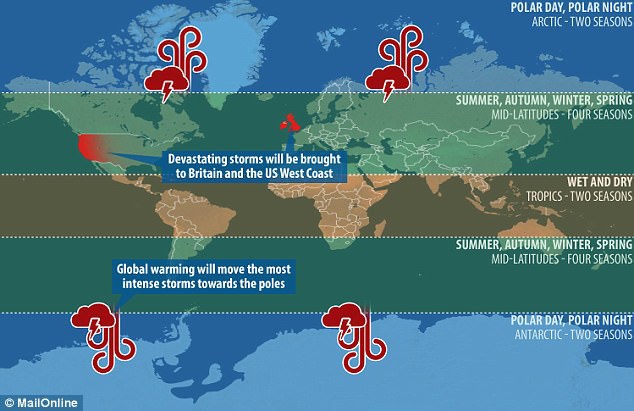
Global warming will bring deadly storms to Britain and the United States by 2100, a study has found. In warming climates, mid-latitude storms will travel further toward the poles before they reach their maximum intensity
Deadly floods and hurricanes will be the ‘new normal’ in Britain and the US west coast by 2100 as global warming causes severe storms to travel further towards the poles
- Storms outside the tropics are often associated with intense rain and wind
- In warming climates these storms will be at their strongest toward the poles
- Impacts will be strongest in regions close to the northeastern ocean boundaries
- These areas include the UK and the west coast of the United States
Global warming will bring deadly storms to Britain and the United States by 2100, a study has found.
In warming climates, mid-latitude storms will travel further toward the poles before they reach their maximum intensity - and this, scientists say, will be the ‘new normal’.
The study suggests that impacts on weather and climate will be strongest in regions close to the northeastern ocean boundaries, such as the UK and the US west coast.
While the storms will not have the power of tropical cyclones like Hurricane Harvey, which hit Houston, Texas in August, or Ophelia, which hit the UK and Ireland in October, the weather events still have the potential to be deadly, the researcher said.
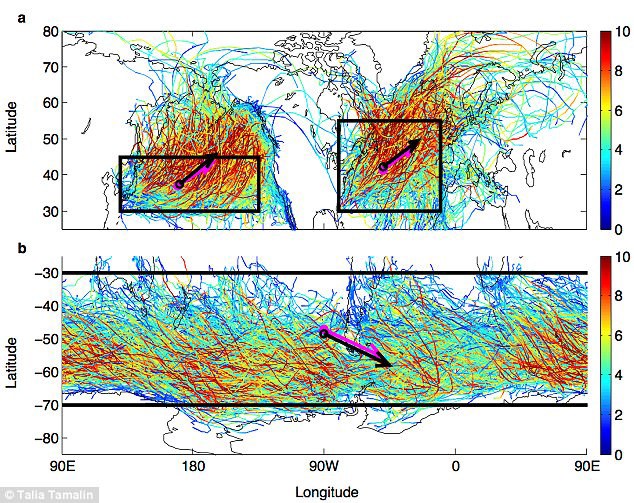
An algorithm allowed the scientists to identify the tracks of individual storms as global temperatures rose (model pictured). They found that a significant part of the poleward shift of storm activity is linked to a longer distance over which the storms build-up in strength
‘Although they are usually weaker than tropical cyclones, midlatitude storms can still be hazardous to people,’ lead researcher Talia Tamalin, from the Weizmann Institute of Science in Rehovot, Israel, told MailOnline.
‘For example, Cyclone Xaver was a powerful European windstorm which crossed northern Europe in early October 2017, and killed at least 7 people in Germany.’
Low-pressure storms outside the tropics are often associated with intense rain and wind.
Based on climate model simulations, their tracks are expected to shift toward the poles in a changing climate.
But scientists have long debated how global warming will cause this global weather change.
To find out, the researchers analysed simulations from 20 state-of-the-art climate models.
The models were run using both the ‘historical’ configuration, which simulated historical global atmospheric conditions, as well as the ‘projected’ configuration.
THE STUDY
- Researchers from the Weizmann Institute of Science, Rehovot, Israel, analysed simulations from 20 state-of-the-art climate models.
- The team used an algorithm that allowed them to identify the tracks of individual storms as global temperatures rose.
- They found that a significant part of the poleward shift of storm activity is linked to a longer distance over which the storms build-up in strength.
- The team suggest this is caused by climate change generating stronger winds at the upper level of the atmosphere, bringing stormy weather.
- Global warming will also and increase concentrations of atmospheric water vapour, triggering heavier rains in mid-latitude regions near the poles.
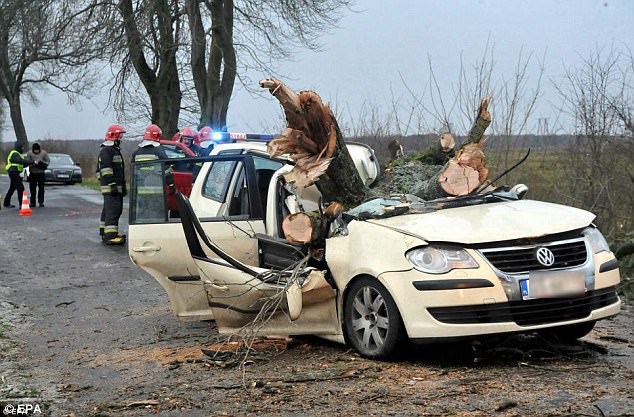
The study suggests that impacts on weather and climate will be strongest in regions close to the northeastern ocean boundaries, such as the UK and the US west coast. Rising temperatures will see a jump in mid-latitude storms, such as Cyclone Xaver (pictured)
HOW GLOBAL WARMING CHANGES STORMS
The team found poleward shift of storm activity will occur thanks to an extended distance over which the storms build-up in strength.
The team suggest this is caused by climate change generating stronger winds at the upper level of the atmosphere.
Previous research has shown that this ‘upper level flow’ is necessary for the storms to grow and also steers them toward the pole.
Global warming will also and increase concentrations of atmospheric water vapour, which further spreads the storms toward the poles.
The hotter air in a warmer climate will contain more water vapour, which will release more heat when the vapour condenses, the researchers said.
The hottest, wettest air circulates up the eastern flank of the storm – to the northern side – and releases latent heat there.
This process pushes the storm northward - or southward in the southern hemisphere - and this effect will be stronger in a warmer climate.
This configuration simulated the atmospheric conditions in a warming climate by increasing CO2 emissions.
The team used an algorithm that allowed them to identify the tracks of individual storms as global temperatures rose.
They found that a significant part of the poleward shift of storm activity is linked to a longer distance over which the storms build-up in strength.
The team suggest this is caused by climate change generating stronger winds at the upper level of the atmosphere.
Previous research has shown that this ‘upper level flow’ is necessary for the storms to grow and also steers them toward the pole.
Global warming will also and increase concentrations of atmospheric water vapour, which further spreads the storms toward the poles.
The hotter air in a warmer climate will contain more water vapour, which will release more heat when the vapour condenses, the researchers said.
The hottest, wettest air circulates up the eastern flank of the storm – to the northern side – and releases latent heat there.
This process pushes the storm northward - or southward in the southern hemisphere - and this effect will be stronger in a warmer climate.
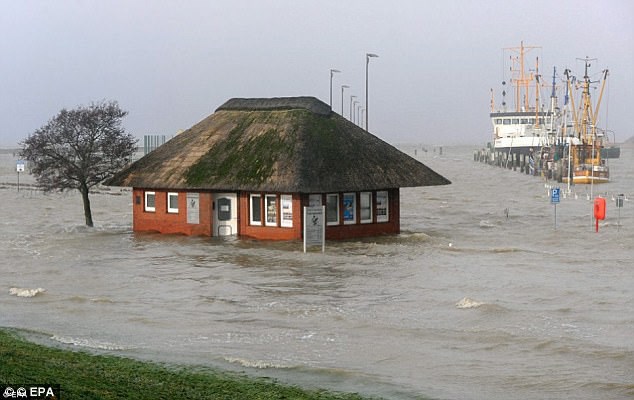
Although they are usually weaker than tropical cyclones, midlatitude storms can still be hazardous to people. Pictured is devastation after Cyclone Xaver, which hit Germany in 2013 causing devestating floods and killing seven
‘Since midlatitude storms in the Northern Hemisphere are mainly generated in the west ocean basins and mainly move eastward and northward, the regions which will be most affected will be those close to the northeastern ocean basins, such as the UK and west coast of Europe, as well as West coast US and Canada,’ Ms Tamalin told MailOnline.
‘Previous studies have shown that in a warmer climate, precipitation associated with extratropical cyclones increases.
‘Hence, there are potentially more hazardous flooding projected over the UK and US.’
Reacting to the study, Dr Tom Bracegirdle, British Antarctic Survey, said: ‘There is an urgent need for the scientific community to work together to understand the behaviour of mid-latitude cyclonic winter storms in a warming world.
‘By isolating the life cycle of individual storms from an analysis of many climate model simulations, this paper adds to the increasing evidence that we can expect more severe winter weather over the UK as cyclones move further poleward under global warming.’
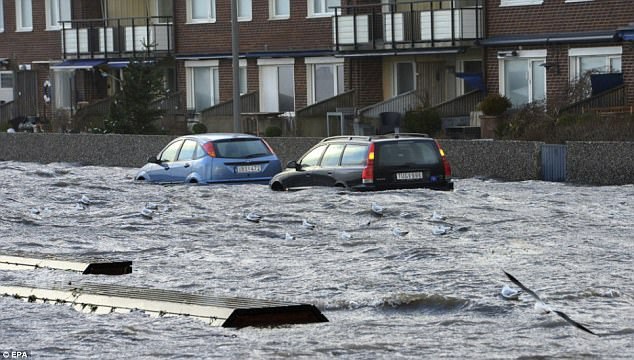
The team suggest that mid-latitude storms, such as 2013's Cyclone Xaver (pictured), will move to the poles thanks to stronger winds at the upper level of the atmosphere generated by global warming
Professor Piers Forster, Director of the Priestley International Centre for Climate at the University of Leeds, added: ‘Climate change may lead to a decreased number to storms world-wide but not for the UK where we are already getting stronger winter storms due to a poleward shift of their track.
‘These storms are bringing stronger winds and more intense rainfall to our shores. Fortunately, they are still not hurricane strength but Ophelia came close and we need to prepare for this becoming the new normal.’
